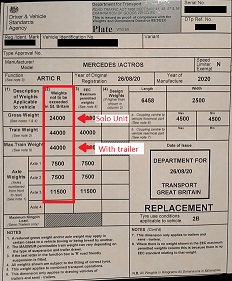stu675:
ROG:
stu675:
What is the point of a 16.5 limit? Surely most trucks would be 18T If they’re not 7.5T. It’s like they want to appear reasonable when they are not!
Its the old max rigid HGV weight and not the current LGV
But wasn’t the LLC actively recently changed from 18T down to 16.5?
There’s a wide range of weight related issues: there’s the actual weight of a vehicle, which may be unladen weight (no load on, and no fuel/other fluids).
Then there’s the kerb weight which includes a full tank of fuel, coolant, etc and all standard equipment, but no load/passengers, and no extras eg hiab, tail lift.
Then the Tare weight, everything you need but no load, ie you’re on the weighbridge ready to work but no load on
Then the Gross Train Weight, ie when there’s something being towed behind
But most practically there’s the maximum it can weigh when on the road (MAM or GVW)
But… there is also the design weight. Sometimes the design weight is higher than the legal maximum weight - we have a 32 tonner that is 37 T design weight, but for the UK the legal max/revenue weight is still 32 T
I’ve seen some tractor units which would be expected to be 44T GTW, but actually have a design weight far in excess of that, and are ready for STGO work right off the production line (Cat 1: 50T, Cat 2: 80T, Cat 3: 150T)
We don’t always need to max-out:
Once a vehicle is over 3.5T the next cut-off point is 7.5T, but there are lots of 5.5T and 6.5T vehicles around
Same with two axled vehicles over 7.5T, where the legal maximum is 18T, unless it is “alternatively fuelled” in which case it is 19T, (both determined by the number of axles). However there are plenty of two-axled rigids of 10T, 12T, 14T or 16T.
Why? Well, one advantage is that if it does not need to be designed and manufactured up to the legal maximum road weight for a two axled rigid, then the VED can be significantly lower. (Google gov.uk Rates of Vehicle Tax
If you like the more technical side of the industry you’d probably like to own a set of the EOS TM-CPC notes, loads of nerdy stuff in there.
